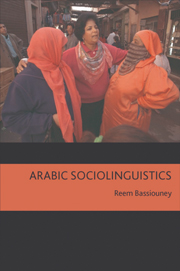Book contents
- Frontmatter
- Contents
- Acknowledgements
- List of charts, maps and tables
- List of abbreviations
- Conventions used in this book
- Introduction
- 1 Diglossia and dialect groups in the Arab world
- 2 Code-switching
- 3 Language variation and change
- 4 Arabic and gender
- 5 Language policy and politics
- General conclusion
- Bibliography
- Index
1 - Diglossia and dialect groups in the Arab world
Published online by Cambridge University Press: 05 August 2013
- Frontmatter
- Contents
- Acknowledgements
- List of charts, maps and tables
- List of abbreviations
- Conventions used in this book
- Introduction
- 1 Diglossia and dialect groups in the Arab world
- 2 Code-switching
- 3 Language variation and change
- 4 Arabic and gender
- 5 Language policy and politics
- General conclusion
- Bibliography
- Index
Summary
Mustafa is still Mustafa. He did not change. He still has two tongues in his mouth, two hearts in his chest. A tongue that speaks for him and a tongue that speaks against him. A heart that speaks for him and a heart that speaks against him. When he speaks sincerely his words are in colloquial. A colloquial that was the only variety he knew and used in narration before. But once he starts speaking what they dictate to him, then he speaks in the language of books, and his words become comic!
Muhra, Mustafa's ex-wife, in Qismat al-ghuramā˒ (‘The debtor's share’) by Yūsuf al-Qa‘īd (2004)This extract from the novel Qismat al-ghuramā˒ (‘The debtor's share’) reflects the tension and ambivalent feelings Egyptians have towards both Modern Standard Arabic (MSA) and Egyptian Colloquial Arabic (ECA). Perhaps it also reflects the tension that exists in all Arab countries, where people speak one language variety at home and learn a different one in school, write in one language and express their feelings in another, memorise poetry in one language and sing songs in another. Whether doing this is practical or not is a moot point. However, as a linguist, one knows that most linguists would agree that whenever one has more than one language or variety at one's disposal, it is indeed a good thing.
- Type
- Chapter
- Information
- Arabic Sociolinguistics , pp. 9 - 27Publisher: Edinburgh University PressPrint publication year: 2009



